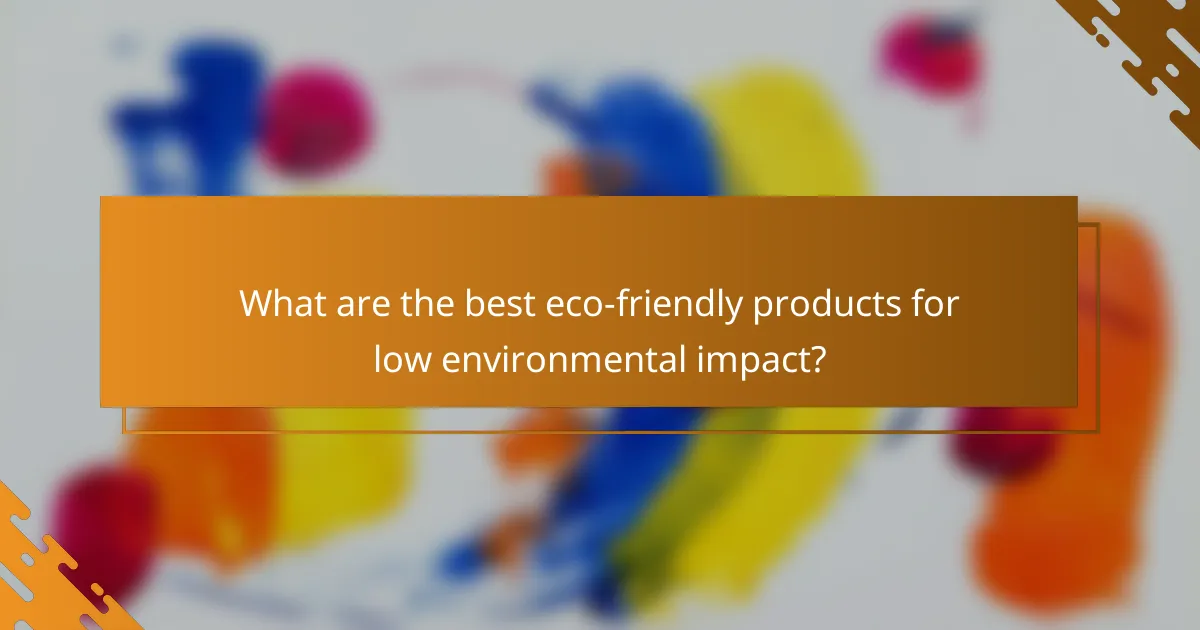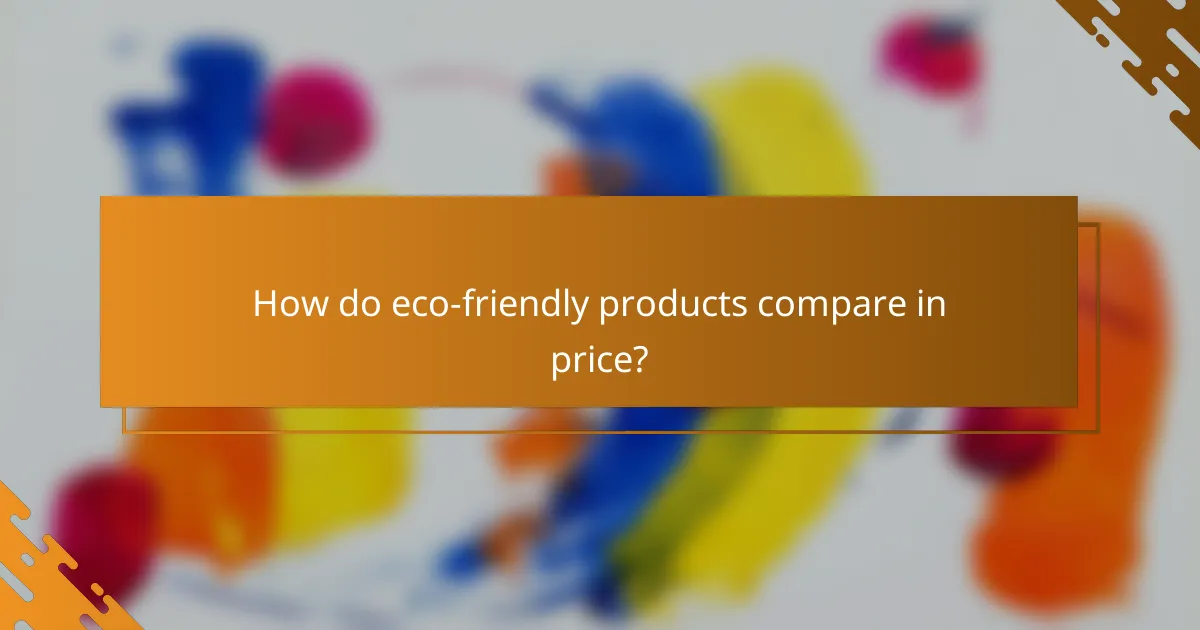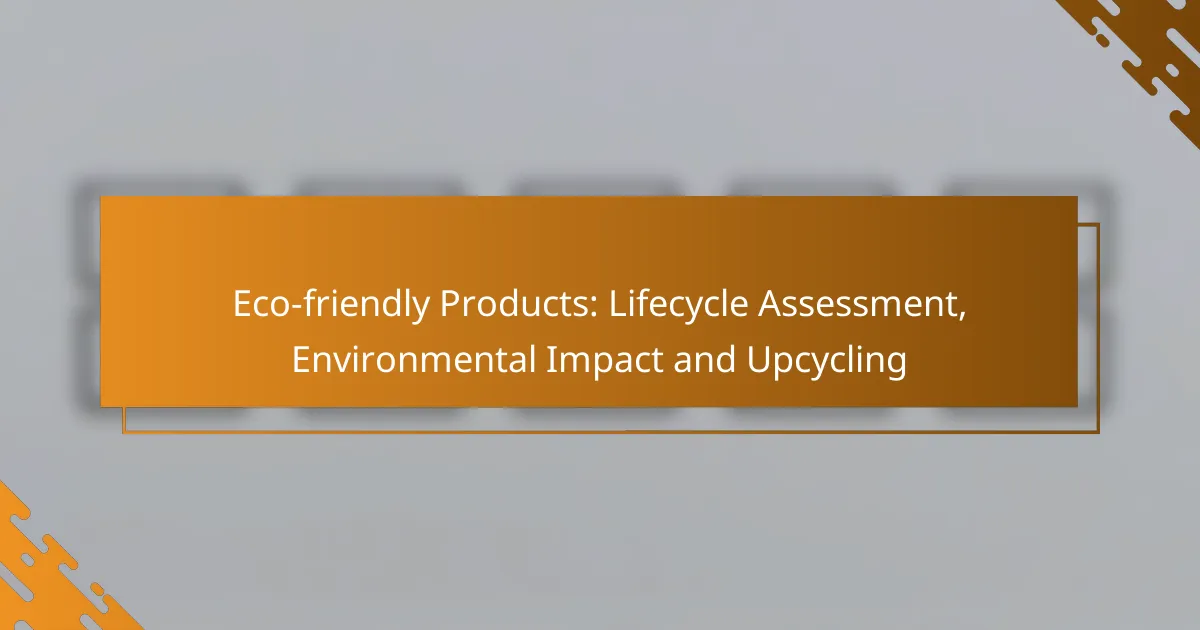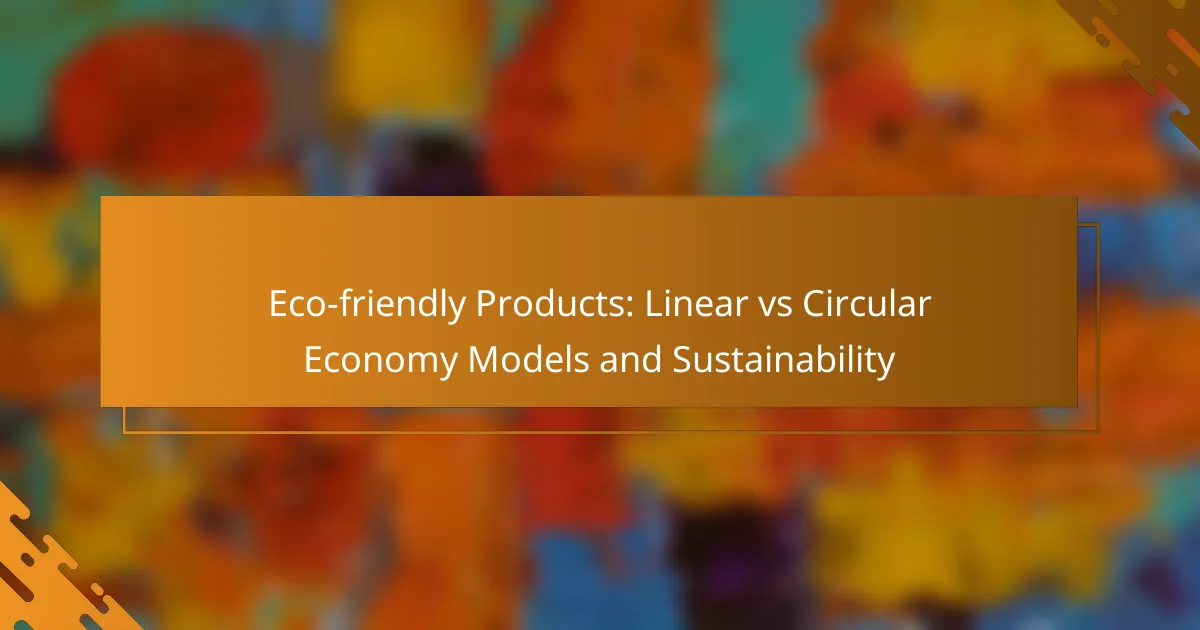Eco-friendly products are designed to minimize waste, reduce pollution, and promote sustainability, making them essential for a healthier planet. When selecting these products, it’s important to consider their environmental impact, sustainability, and relevant certifications. By choosing eco-friendly options, consumers can enjoy the benefits of reduced environmental harm and improved health, all while supporting a more sustainable lifestyle.

What are the best eco-friendly products for low environmental impact?
The best eco-friendly products for low environmental impact are those that minimize waste, reduce pollution, and promote sustainability. Key categories include biodegradable cleaning supplies, reusable shopping bags, solar-powered gadgets, organic personal care items, and energy-efficient appliances.
Biodegradable cleaning supplies
Biodegradable cleaning supplies break down naturally and do not contribute to long-term pollution. Look for products that are certified by recognized standards, ensuring they decompose within a specific timeframe without leaving harmful residues.
Common options include plant-based detergents, vinegar-based cleaners, and biodegradable wipes. When selecting these products, check labels for certifications like the EPA Safer Choice or similar eco-labels to ensure their environmental claims are valid.
Reusable shopping bags
Reusable shopping bags significantly reduce plastic waste by replacing single-use plastic bags. Made from materials such as cotton, jute, or recycled plastics, these bags can be used multiple times, making them a sustainable choice.
When choosing reusable bags, consider their durability and ease of cleaning. A good rule of thumb is to select bags that can hold at least 15-20 kg to accommodate your shopping needs while minimizing the number of bags required.
Solar-powered gadgets
Solar-powered gadgets harness sunlight to generate energy, reducing reliance on fossil fuels. These products range from solar chargers for devices to solar-powered lights and outdoor equipment.
When selecting solar gadgets, check their efficiency ratings and battery capacity. Look for models that can fully charge within a few hours of direct sunlight for optimal performance, especially in regions with ample sunlight.
Organic personal care items
Organic personal care items are made from natural ingredients that are free from synthetic chemicals and harmful additives. These products include skincare, haircare, and cosmetics that prioritize health and environmental safety.
To ensure the organic claims are legitimate, look for certifications such as USDA Organic or similar. Pay attention to ingredient lists and avoid products with long chemical names or those that are not easily recognizable.
Energy-efficient appliances
Energy-efficient appliances consume less electricity, helping to lower energy bills and reduce carbon footprints. Look for appliances with the ENERGY STAR label, which indicates they meet strict energy efficiency guidelines.
When purchasing new appliances, consider their energy consumption ratings and estimated annual operating costs. Investing in energy-efficient models can lead to savings over time, making them a practical choice for eco-conscious consumers.

How to choose eco-friendly products?
Choosing eco-friendly products involves evaluating their environmental impact, sustainability, and certifications. Focus on products that minimize harm to the planet while meeting your needs.
Look for certifications like Energy Star
Certifications such as Energy Star indicate that a product meets strict energy efficiency guidelines set by the U.S. Environmental Protection Agency. These labels help consumers identify appliances and electronics that use less energy, reducing both utility bills and carbon footprints.
Other certifications to consider include Fair Trade, USDA Organic, and Cradle to Cradle, which signify various aspects of sustainability and ethical production. When shopping, look for these labels to ensure your choices align with eco-friendly standards.
Assess materials and sourcing
Investigate the materials used in products, as sustainable materials like bamboo, recycled metals, and organic cotton have lower environmental impacts. Avoid products made from harmful substances such as PVC or those that contribute to deforestation.
Additionally, consider where and how the materials are sourced. Local sourcing can reduce transportation emissions, while fair labor practices ensure ethical production. Research brands that prioritize transparency in their supply chains.
Consider product lifecycle
Understanding a product’s lifecycle—from production to disposal—can help you make more informed choices. Look for items designed for longevity, repairability, and recyclability, which minimize waste and resource consumption over time.
Evaluate whether the product can be reused or recycled at the end of its life. For instance, products with take-back programs or those made from biodegradable materials are preferable. This approach not only benefits the environment but can also save you money in the long run.

What are the benefits of using eco-friendly products?
Using eco-friendly products offers numerous benefits, including a reduced environmental impact and improved health. These products are designed to minimize harm to the planet while promoting a healthier lifestyle for consumers.
Reduced carbon footprint
Eco-friendly products typically have a lower carbon footprint compared to conventional alternatives. This reduction is achieved through sustainable sourcing, energy-efficient manufacturing processes, and biodegradable materials. By choosing these products, consumers can significantly decrease their contribution to greenhouse gas emissions.
For example, opting for reusable bags instead of single-use plastic bags can cut down on plastic waste and the energy used in production. Additionally, selecting products made from recycled materials further reduces the overall carbon impact.
Healthier living environment
Eco-friendly products often contain fewer harmful chemicals, which can lead to a healthier living environment. Many conventional products release volatile organic compounds (VOCs) and other toxins that can affect indoor air quality. By using eco-friendly alternatives, individuals can reduce their exposure to these harmful substances.
For instance, natural cleaning products made from plant-based ingredients are safer for both people and pets compared to traditional cleaners laden with harsh chemicals. This shift can result in fewer allergic reactions and respiratory issues, contributing to overall well-being.
Support for sustainable brands
Purchasing eco-friendly products supports brands that prioritize sustainability and ethical practices. Many of these companies focus on environmentally responsible sourcing, fair labor practices, and community engagement. By choosing to buy from these brands, consumers can help promote a market that values sustainability.
Moreover, supporting sustainable brands often encourages innovation in eco-friendly technologies and practices, leading to a broader range of environmentally conscious products available in the market. This collective consumer behavior can drive significant change in industries, pushing more companies to adopt sustainable practices.

How do eco-friendly products compare in price?
Eco-friendly products often have a higher upfront cost compared to conventional alternatives, but they can lead to significant long-term savings. The price difference is influenced by factors such as production methods, materials used, and brand positioning.
Initial investment vs. long-term savings
When considering eco-friendly products, the initial investment can be higher due to sustainable materials and ethical manufacturing processes. However, these products are typically designed to last longer and perform better, which can reduce replacement costs over time.
For example, energy-efficient appliances may cost more upfront but can save consumers hundreds of dollars on utility bills annually. Similarly, reusable items like water bottles or shopping bags can eliminate the need for single-use products, leading to savings in the long run.
Price comparisons of brands
Price comparisons among eco-friendly brands can vary widely based on quality and sustainability practices. Some brands may offer affordable options while others position themselves as premium products, reflecting their commitment to environmental standards.
For instance, organic cleaning products can range from $5 to $15 per bottle, depending on the brand and ingredients. It’s beneficial to compare similar products across different brands to find the best value while ensuring they meet eco-friendly criteria.

What are the shipping and return policies for eco-friendly products?
Shipping and return policies for eco-friendly products vary by retailer but generally prioritize sustainability. Many companies offer eco-conscious shipping options and flexible return policies to enhance customer satisfaction while minimizing environmental impact.
Eco-conscious shipping options
Eco-friendly shipping options often include carbon-neutral delivery services, which offset emissions by investing in renewable energy projects. Some retailers use biodegradable packaging materials or recycled content to reduce waste.
When selecting a shipping method, consider local delivery services that utilize electric vehicles or bicycles. This not only supports local businesses but also reduces the carbon footprint associated with long-distance shipping.
Return policies of major retailers
Major retailers typically offer return policies that accommodate eco-friendly products, allowing customers to return items within a specified period, often ranging from 30 to 90 days. Some retailers even provide free return shipping to encourage sustainable purchasing decisions.
It’s advisable to check the specific return guidelines for eco-friendly items, as some may have stricter conditions due to their unique materials or production processes. Always retain original packaging to facilitate easier returns.



